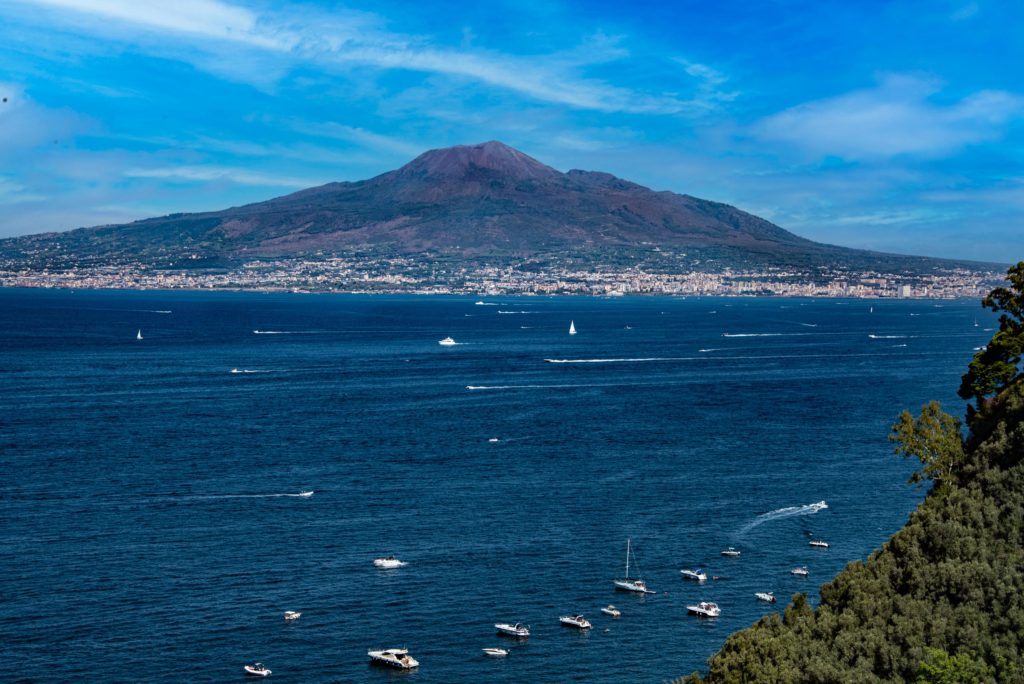February 2022

After an eye-opening visit to the well-preserved ruins of Pompeii in southern Italy’s Campania region, we decide to climb that city’s destroyer five miles away, Mount Vesuvius. A popular activity for tourists and locals alike, hundreds of climbers make the trek daily to peer into the volcano’s caldera.
Mount Vesuvius National Park, established in 1995, hosts a handful of trails of varying difficulties and landscapes that ascend to the summit. We opt for the main trail, a ten-foot-wide gravel surface zigzagging over a half mile up, with guard rails on the down slope side to prevent unfortunate missteps. For us, the rail also provides a climbing aid we use occasionally to pull ourselves along.
It’s not considered a challenging climb. But with a 30º slope at times, the trail puts our legs to the test after a while. Periodic breath-catching reminds me to increase my aerobic gym workout when I return home. It takes an hour to reach the caldera. We certainly represent an older age cohort making the climb, and we take our time as young people practically run past us in both directions.
Gravelly pumice stone covers steep slopes on either side of this trail, from pea-sized pebbles to larger rocks measuring several inches across. Several feet of this stuff rained down on Pompeii for hours August 24, 79 A.D. in the first of two waves of devastation from the eruption. (Recent archeologists’ discoveries now suggest mid-October as the eruption date.) Pumice filled the streets and first floors of houses, killing early victims in these stone showers that knocked them down and quickly buried them. Later that day, pyroclastic blasts of superheated toxic gases and ash finished the job of burying Pompeii feet under 21 of volcanic discharge.
I count five varieties of wildflowers valiantly struggling here and there, breaking through this inhospitable ground to bloom victoriously. They provide the only relief from the gray, barren landscape. Lychnis ‘Vesuvius,’ a fiery orange-red flower likened to molten lava’s color, shouts out its presence. I vow to add this stunner to my own garden.
Despite the bleak landscape along this path, volcanoes like Vesuvius usually deposit material around their bases that eventually transforms into rich soil. Farmers and communities are attracted back to the environment around these deadly vents in the earth’s crust once they settle down again. Over 16,000 people perished from the 79 A.D. eruption that blew almost a third of the mountain’s top off, burying Pompeii, Herculaneum, Oplontis, and Stabiae. Today the mountain rises 4200 feet above the sea.
We stroll the last few hundred feet on mostly level ground with a grand sense of accomplishment and peer into the 1000-foot-deep caldera. Clouds race above and around us. No legendary wisps of hot, gaseous air curl up from the bottom of the crater; yet its ever present heat entices a cloud strand to break away and dive into Vesuvius’ maw, twisting and swirling until it evaporates. A uniformed team of men and women take turns descending the steep pumice slopes on climbing ropes with a folded stretcher to practice rescue missions.
We turn around to take in the magnificent view of Naples, its busy port, and surrounding suburbs, with the calm, blue Bay of Naples filling the horizon. Six million people exist at the base of one of the world’s deadliest volcanoes; three million are vulnerable to the next cataclysmic event.
Vesuvius’ last major eruption in 1944 at the height of World War II produced enough rumblings and gaseous smoke ahead of its explosion to allow the town of San Sebastiano’s inhabitants, with the help of Allied soldiers, to evacuate before the volcano flattened their city.
And Vesuvius will erupt again, volcanologists promise. It’s just a matter of time.

